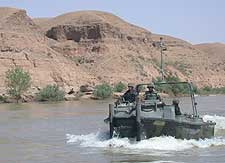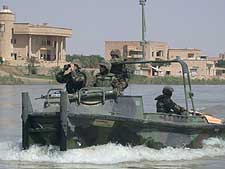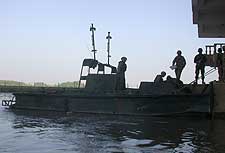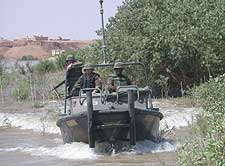 |
| High bluffs line the right (west) bank of the Tigris in this area. |
Members of Army Engineer units based in Tikrit, Iraq, are mounting river patrols in a �nondoctrinal� operation that taps the combat side of the combat engineers� roots. The 565th Engineer Battalion has run the patrols round-the-clock on the Tigris River since arriving at Saddam Hussein�s home town of Tikrit on April 23.
President Bush on May 1 declared the combat phase of the war in Iraq over and launched the national rebuilding effort to establish a new Iraqi political system and restore the country to economic health. But loyalists of the fallen regime have continued low-grade attacks�ambushes, sniping, road minings and other small-unit actions�on coalition forces that have taken the lives of seven U.S. soldiers in the past week. Military officials now are reassessing the threat to determine whether it indicates that organized resistance is persisting.
The Tigris River is an asset of towering importance to Iraq, a land the Greeks called Mesopotamia��The Land amid the Rivers.� It is a commercial highway and a source of food and water for irrigation, drinking and hydroelectric power for the half of the country not served by the other major river, the Euphrates. Controlling the river is key to controlling the country, and that fact has launched the 565th Engineer Battalion�s small river patrol fleet.
 |
| Boat Operator Spec. Kelly Lynch (foreground) shows Pv2 Joshua Gauthier how to operate the boat in case Gauthier, who normally serves as security, is required to take over. Senior Boat Staff Sgt. Terrence Brown observes at right. |
�One thing we try to do is keep the soldiers from getting complacent�let them know there are still bad guys out there,� says First Sergeant Henry Hart III, the battalion sergeant major. To prepare for the mission, Hart found his bridge builders needed refresher training in infantry tactics. Most of them had not performed as infantry since they completed basic training. Over a couple of weeks, he put two platoons�about 100 soldiers�of the 502nd Assault Float Bridge Co. through training in weapons, actions on contact, indirect fire and apprehension techniques. A second group now is in training from the 814th Engineer Co. of the 46th Engineer Battalion.
At dusk on June 3, Staff Sgt. Terrence Brown, Senior Boat for a two-boat patrol, oversees his patrol�s preparations for the coming night�s work. Run-times for the eight-person patrols typically range at random between 20 and 90 minutes. Each boat carries an operator, a crew chief or the senior boat and two soldiers for security. Weapons consist of an AT-4 antitank weapon, an M-249 5.5-mm machine gun and three M-16 assault rifles.
Spec. Kelly Lynch, a boat operator, checks the oil and operating system, shadowed by Pv2 Joshua Gauthier. Gauthier, who normally provides security, is becoming familiar with operation of the boat in case he must take over the controls.
Brown�s patrols operate on the north side of a 556-m float bridge the Engineers threw across the Tigris as a temporary replacement for the bomb-damaged fixed bridge. A second pair of boats patrols south of the bridge. Patrols run round-the-clock, seven days a week.
Daytime patrols mostly encounter fishermen and other innocent traffic, says Lt. Col. Richard Hornack, battalion commander. �As long as they stay on [the eastern] side of the river, we don�t care what they do,� he says. But traffic that approaches the western side, where the government palace compound now occupied by U.S. forces stands, is stopped and ordered away from the compound.
About a week ago, in broad daylight, U.S. forces observed a furiously paddling boatload of Iraqis enter the river on the far side after the patrol had gone south. �We radioed the boat to come back and check these guys out, and they were back in 10 minutes,� says Hornack. �They tested us that day, to see how fast we would respond.�
At 11:45 p.m., four 212-horsepower Sabre engines come to life with a throaty growl, then purr as they warm up. With Hornack and a reporter as added passengers, the two 23-ft boats back out of the slip and head north under the fixed bridge. The sky is black. The less-than-first-quarter moon set an hour before, but watchers peering through night-vision goggles clearly see a green-tinted riverscape. The goggles also reveal infrared beacons, invisible to the naked eye, flashing from the masts, identifying the boats as friendly to Blackhawk helicopters and to each other.
The boats, in echelon right (one following the lead off the starboard quarter), run 2 km upriver, round the tip of an island and drift quietly south. Watchers scan the skyline marked by high bluffs looming over the west bank. When a crew member spots a red star-cluster flare back to the north, the patrol turns and speeds back to the area.
 |
| Daylight patrol occurs against the backdrop of a riverside complex of government palaces now occupied by U.S. Army units. |
�Do you know what that means?� Hornack coaches a security soldier. �That�s how the enemy communicates with each other. It could mean, �We see the Americans coming�set an ambush� or, �They�re getting close to one of our arms caches.� We don�t know exactly what it means, but we know they are talking to each other.� The soldier asks whether they are civilians. �No, they�re trained by the army or by Al Qaeda. They know how to use their weapons. They�re sharp; they�re good.� They operate in units of three to five, he says.
The patrol lingers with idling engines by a water-pumping station, watching for other evidence of enemy action and calling in the approximate location of the flare�s origin. Brown says he saw a green star-cluster as well. After 10 minutes, the boats nose into the river and head downstream again, completing another patrol.
 |
| Patrol boat crew members check over the vessels and their equipment at dusk for a night patrol. |
Ashore, Hornack goes to the southern boatslip, where the patrol is waiting for him. The senior boat briefs him on the movement pattern selected for this patrol. Harnack praises the leader for the matrix he has developed to select random movement patterns. �You want to keep changing your pattern,� he says. �Don�t ever become predictable. Don�t repeat the same kind of patrol. If you always come by at the same time, one night they�ll hit you with rocket-propelled grenades and machine guns and kill everybody.�
 |
| Shallow-draft boats weave through vegetation on submerged islands in search of infiltrators. |
The northern patrols recently have been mostly uneventful, says Hornack, but a few attacks have been launched on the Tikrit base from the south. All eyes strain, looking for signs of movement on the broad, swift-flowing river and on the mostly undeveloped east bank opposite the palace compound. At the southern end of the patrol, about 2 km downstream, he points out a large area of marshes. �We patrol these marshes pretty closely. If they crossed the river and infiltrated the marshes, we�d never be able to see them before they came out of the reeds and attacked us.� In daylight, it is clear that the river is relatively narrow at this point, making clandestine crossing easier than elsewhere.
But the river is quiet tonight. Apart from the star-clusters, there is no sign of possible trouble. Floating on the fast-moving water in the mild evening breeze, it�s hard to imagine violent action. But news and intelligence reports from throughout central Iraq have overtaken imagination. This is still a war zone and it could heat up again. The combat engineers remain on alert.
(Photos by Thomas F. Armistead for ENR)
![]()
 |
ENR Associate Editor Thomas F. Armistead is in the Mideast region with elements of Army Corps of Engineers and private contractors.



Post a comment to this article
Report Abusive Comment